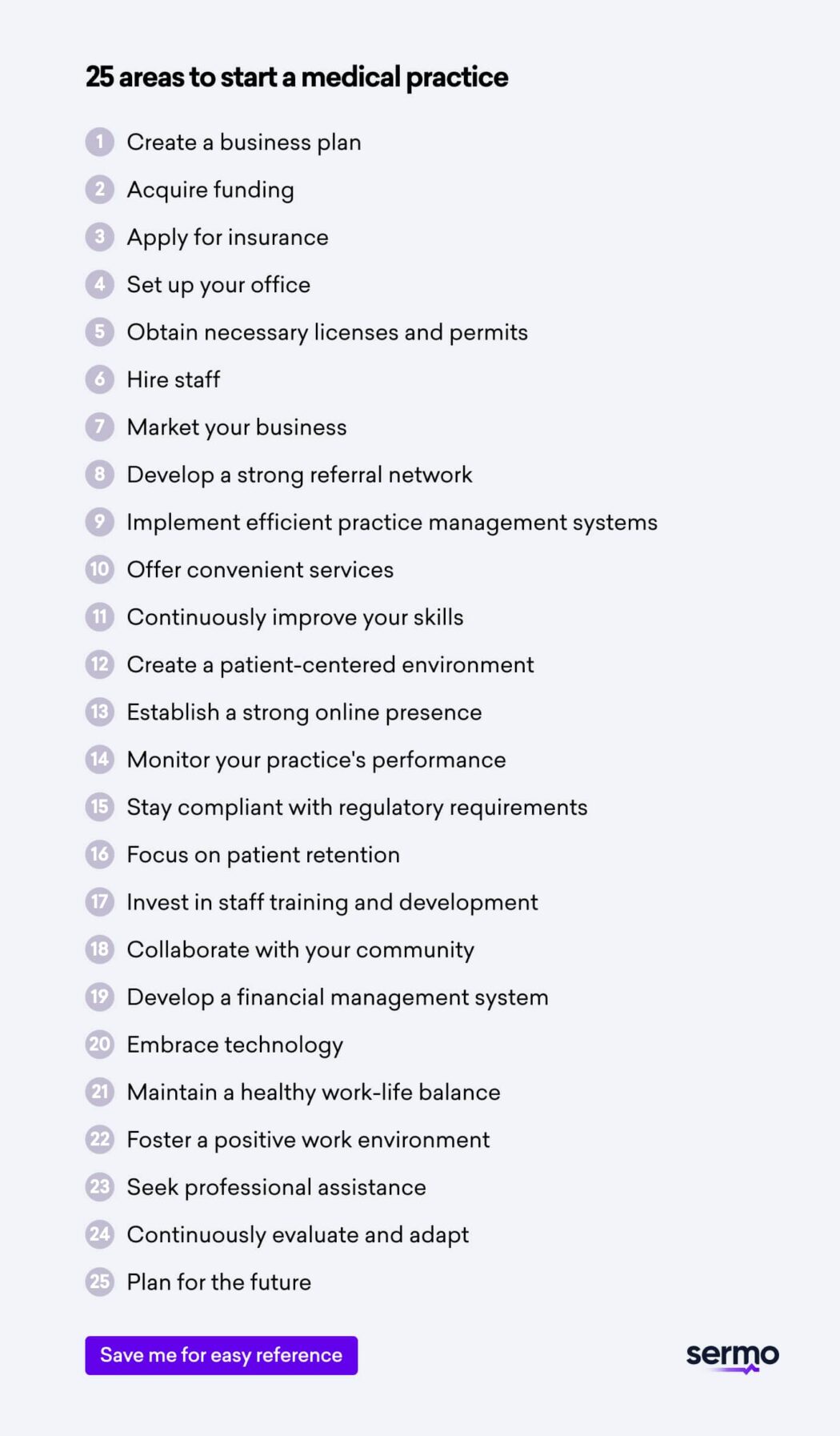
Taking the leap to start your own medical practice or hospital is a significant decision for physicians looking to have more control over their professional lives, provide personalized care to their patients, and enjoy the potential financial benefits that come with running a successful business. In a Sermo survey, 43% of polled physicians stated that they owned their own medical practice. Furthermore, 40% reported that the ability to be the decision maker was the reason behind this decision. However, the path to starting a medical practice, opening a medical practice or starting a hospital, can be complex and requires careful planning and consideration.
In this guide, we discuss the benefits and drawbacks of starting your own medical practice, outline the necessary considerations, and provide a detailed step-by-step guide on how to start a medical practice. Additionally, we showcase services, which can be invaluable in helping physicians navigate the challenges of starting and managing their own practice.
Should you start your own medical practice?
Starting a medical practice is no small feat, for many physicians, the main question remains, “where do I go to learn how to start a medical practice”? Before diving into the specifics of how to open a private practice or how to open a hospital, it’s essential to understand the benefits and drawbacks of this endeavor.
Medical practices benefits
- More control over patient care: Physicians who start their own practice have greater autonomy in deciding how to provide care, allowing them to tailor treatments to their patients’ needs and preferences.
- Increased financial potential: In a recent Sermo survey, a Urologist in Spain reinforced “Private clinical practice is an area that allows you to have higher income”. Owning a medical practice can be financially rewarding, with the potential for higher income as the practice grows and becomes more successful.
- Greater flexibility: Running a private practice allows physicians to set their schedules, manage their workload, and create a work-life balance that suits their needs.
Medical practices drawbacks
- Initial investment: Starting a medical practice requires a significant financial investment for startup costs, including equipment, office space, and staff salaries.
- Increased workload: Physicians who start their own practice must manage various administrative tasks, such as billing, marketing, and human resources, in addition to their medical responsibilities. These can impact a doctor’s work life balance.
- Risk: Like any business venture, starting a medical practice comes with the risk of failure and potential financial loss.
“Starting a private practice is a bit complicated – we (me and 2 partners) were fortunate to have an excellent mentor who immensely helped and guided us. The best advice is to find not only competent advisors but also staff which can be difficult” shared a U.S. based Cardiologist in a recent Sermo survey.
Considering the benefits and drawbacks, starting a medical practice might be a good fit for physicians who are highly motivated, entrepreneurial, and willing to invest time and resources into building a successful business.

Starting a medical practice: 4 key considerations
Before embarking on the journey of starting your own practice or starting your own hospital, physicians should consider the following:
- Type of practice: Decide whether you want to start a solo practice, join a partnership, or establish a group practice.
- Time requirements: Understand the time commitment required to manage both medical and administrative responsibilities.
- Funding: Determine the necessary startup costs and how you will secure funding for your practice.
- Location: Choose a suitable location for your practice, considering factors like demographics, competition, and accessibility.
How to start a private medical practice: 25 easy steps
With a clear understanding of the benefits, drawbacks, and considerations, you can now dive into the detailed process of how to start a medical practice or how to open a medical clinic.
- Create a business plan: Develop a comprehensive business plan outlining your practice’s mission, target market, services offered, staffing requirements, financial projections, and marketing strategies. This plan will serve as a roadmap for your practice and can be crucial in securing funding.
- Acquire funding: Explore various funding options, such as bank loans, personal savings, or investments from family and friends. Ensure that you have sufficient capital to cover startup costs and sustain your practice during the initial months of operation.
- Apply for insurance: Obtain malpractice insurance to protect yourself and your practice from potential liability claims. Additionally, consider other insurance policies, such as general liability, property, and workers’ compensation.
- Set up your office: Find a suitable location for your practice and set up your office space. Invest in essential equipment, furniture, and technology, such as electronic health records (EHR) systems, to ensure a smooth operation.
- Obtain necessary licenses and permits: Research and apply for the required licenses and permits, including a medical license, state business license, and Drug Enforcement Administration (DEA) registration.

- Hire staff: Recruit qualified staff members, including nurses, medical assistants, and administrative personnel. Ensure that your team is knowledgeable, professional, and aligned with your practice’s mission and values.
- Market your business: Develop and execute a marketing plan to attract new patients and establish your practice’s reputation. Utilize digital marketing strategies, such as search engine optimization (SEO), social media, and email campaigns, to reach potential patients. Additionally, consider traditional marketing methods like print advertising, direct mail, and community outreach.
- Develop a strong referral network: Among polled Sermo physicians, 52% reported that they would reach out to other medical practices in the area for advice, if starting up their own practice.
Cultivate relationships with other healthcare providers and specialists in your area to create a robust referral network. This will help increase your patient base and enhance your practice’s reputation.

- Implement efficient practice management systems: Streamline your administrative tasks by implementing efficient practice management systems, such as EHR, billing, and appointment scheduling software. These systems will help save time, reduce errors, and improve overall patient experience.
- Offer convenient services: Differentiate your practice by offering convenient services, such as telemedicine, extended office hours, and online appointment scheduling, to attract and retain patients.
- Continuously improve your skills: Stay current with the latest medical advancements and best practices by participating in continuing medical education (CME) programs. This commitment to ongoing learning will help you provide the best possible care to your patients and enhance your professional reputation.
- Create a patient-centered environment: Prioritize patient comfort and satisfaction by creating a welcoming, patient-centered environment. This includes designing a comfortable waiting area, offering refreshments, and ensuring that your staff is friendly and attentive.
- Establish a strong online presence: In today’s digital age, having a strong online presence is crucial for any business, including medical practices. Create a professional website that showcases your services, credentials, and testimonials from satisfied patients. Additionally, establish a presence on social media platforms to engage with potential patients and share helpful information and updates about your practice.
- Monitor your practice’s performance: Regularly evaluate your practice’s performance, including financials, patient satisfaction, and staff efficiency, to identify areas of improvement and growth. This will help you make informed decisions and ensure the long-term success of your practice.
- Stay compliant with regulatory requirements: Keep up-to-date with the latest healthcare regulations and ensure that your practice remains compliant with all necessary rules and guidelines. This includes maintaining patient privacy through HIPAA compliance and adhering to federal and state healthcare laws.

- Focus on patient retention: While attracting new patients is essential for growing your practice, retaining existing patients is just as crucial. Provide exceptional patient care, maintain consistent communication, and address any concerns or feedback to ensure patient satisfaction and loyalty.
- Invest in staff training and development: A well-trained and competent staff is critical to the success of your medical practice. Invest in ongoing training and development programs for your team members to ensure they stay current with the latest industry trends and best practices.
- Collaborate with your community: Build relationships with other healthcare providers, community organizations, and local businesses in your area. Engage in community events and support local initiatives to increase your practice’s visibility and reputation.
- Develop a financial management system: Implement a robust financial management system to track your practice’s income and expenses. Regularly review financial statements and analyze key performance indicators (KPIs) to identify areas for improvement and make informed decisions about your practice’s financial health.
- Embrace technology: Stay current with the latest technological advancements in healthcare and incorporate them into your practice when appropriate. This may include adopting telehealth services, implementing electronic prescribing systems, utilizing advanced diagnostic tools or integrating generative AI into your processes.
- Maintain a healthy work-life balance: Running a medical practice can be demanding and time-consuming. Prioritize self-care and maintain a healthy work-life balance to prevent burnout and ensure long-term success in your career.
- Foster a positive work environment: Create a positive work environment where staff members feel supported, valued, and motivated to perform their best. Encourage open communication, recognize achievements, and provide opportunities for professional growth.
- Seek professional assistance: Don’t hesitate to seek professional assistance for various aspects of your practice, such as legal, accounting, medical billing or marketing services. These professionals can provide valuable guidance and support, allowing you to focus on providing exceptional patient care.
- Continuously evaluate and adapt: The healthcare industry is constantly evolving, and your medical practice must be prepared to adapt to these changes. Regularly evaluate your practice’s performance, processes, and services, and be ready to make necessary adjustments to stay competitive and successful.
- Plan for the future: Consider the long-term goals and vision for your practice. Develop a succession plan, explore opportunities for expansion or partnership, and stay informed about emerging healthcare trends that may impact your practice’s future.
By following these best practices and leveraging the support and resources available through Sermo, physicians can successfully start and manage their medical practice, providing exceptional care to their patients while enjoying the benefits of practice ownership. As you embark on the journey of how to start your own medical practice, it is essential to have a comprehensive understanding of various aspects of the process. In addition to the steps and best practices outlined earlier, the following sections will delve deeper into specific areas that are critical for the successful establishment and operation of your medical practice.

Choosing the right practice model
Whether it’s after years of work, or right out the gate finishing medical education, starting your own medical practice can be a dream come true for capable and business-minded physicians. Selecting the appropriate practice model is a crucial decision that will shape the structure and operations of your medical practice. There are several practice models to choose from, each with its advantages and disadvantages. Some of the most common practice models include:
- Solo practice: In this model, you operate independently and have complete control over all aspects of your practice, from clinical decisions to business management. While this model offers the most autonomy, it also comes with the responsibility of managing all aspects of the practice, which can be time-consuming and challenging.
- Group practice: In a group practice, you join forces with other physicians to share resources, expenses, and responsibilities. This model allows for a more collaborative approach to patient care and can provide greater stability and support. However, it may also involve compromises and negotiations among the group members, which can be a drawback for some physicians.
- Employment model: In this model, you become an employee of a hospital or healthcare organization, relinquishing some control over the practice’s operations and decision-making. While this model provides a more stable income and benefits, it may not be ideal for physicians seeking greater autonomy and control over their practice.
- Concierge medicine: This practice model involves charging patients an annual fee in exchange for personalized, on-demand care and additional services. This model can offer greater financial stability and flexibility, but it may limit the number of patients you can serve and may not be suitable for all specialties.
- Telemedicine: With the increasing popularity of telehealth services, some physicians choose to establish a virtual practice, providing remote consultations and care to patients through digital platforms. This model offers flexibility and reduced overhead costs but may not be appropriate for all specialties and patient populations.
When choosing a practice model, consider factors such as your personal preferences, financial goals, and the needs of your target patient population. Evaluate the advantages and disadvantages of each model and select the one that best aligns with your vision for your medical practice.

Securing funding and managing finances
Starting a medical practice requires a significant initial investment, including costs for office space, equipment, staff salaries, and marketing. Securing adequate funding is essential to cover these expenses and ensure the successful launch of your practice. There are several options for obtaining funding, such as:
- Personal savings: Using your personal savings is the most straightforward funding option but may not be sufficient for covering all startup costs.
- Bank loans: Many banks offer loans specifically for medical practices. This option requires a solid business plan and credit history to secure approval.
- Small Business Administration (SBA) loans: The SBA offers loans to small businesses, including medical practices, through their 7(a) loan program. These loans typically have lower interest rates and longer repayment terms than traditional bank loans.
- Private investors: Some physicians choose to partner with private investors who provide funding in exchange for a share of the practice’s profits.
- Equipment leasing: Leasing medical equipment instead of purchasing it outright can help reduce upfront costs and provide more manageable monthly payments.
In addition to securing funding, it is crucial to develop a comprehensive financial management system for your practice. This includes setting up a separate business bank account, implementing accounting software, and establishing a budget and financial projections. Regularly monitor your practice’s financial performance and make adjustments as needed to ensure its long-term success.
Creating a patient acquisition strategy
Attracting and retaining patients is critical for the success of your medical practice. Develop a patient acquisition strategy that includes a combination of marketing and networking efforts to increase your practice’s visibility and attract new patients. Some key components of an effective patient acquisition strategy include:
- Building a professional website: A well-designed, user-friendly website is essential for showcasing your practice’s services, staff, and contact information. Ensure your website is optimized for search engines and mobile devices to increase its visibility and accessibility.
- Engaging in local marketing: Utilize local marketing strategies, such as maintaining your Google My Business profile, print advertisements, direct mail campaigns, and community event sponsorships, to increase your practice’s presence in your local community.
- Leveraging social media: Establish a social media presence on platforms such as Facebook, Twitter, and LinkedIn to share valuable content, engage with potential patients, and showcase your practice’s expertise and personality.
- Developing a referral network: Build relationships with other healthcare providers, community organizations, and local businesses to establish a referral network that can help drive new patients to your practice.
- Offering promotions and incentives: Attract new patients by offering promotional discounts, free consultations, or other incentives for first-time patients.
- Collecting and showcasing patient testimonials: Encourage satisfied patients to leave reviews on online platforms like Google or Yelp, and share their positive experiences with friends and family. Display these testimonials on your website and marketing materials to demonstrate the quality of care your practice provides.
- Utilizing Search Engine Optimization (SEO) and Pay-Per-Click (PPC) advertising: Implement SEO strategies to improve your website’s search engine rankings and invest in targeted PPC advertising campaigns to drive traffic to your site.

Implementing efficient operational processes
Efficient operational processes are critical for the smooth functioning of your medical practice and ensuring patient satisfaction. Establish systems and procedures for various aspects of your practice, such as appointment scheduling, billing and coding, and medical records management. Some tips for implementing efficient operational processes include:
- Adopting an Electronic Health Record (EHR) system: An EHR system can streamline the management of patient records, improve communication among staff members, and reduce errors in documentation and billing.
- Implementing a practice management system: A practice management system can help automate tasks such as appointment scheduling, billing, and reporting, saving time and reducing the risk of errors.
- Establishing Standard Operating Procedures (SOPs): Develop SOPs for various aspects of your practice, such as patient check-in and check-out, prescription management, and referral processing. Ensure all staff members are trained on these procedures and follow them consistently.
- Optimizing appointment scheduling: Implement an efficient appointment scheduling system that minimizes patient wait times, maximizes provider productivity, and allows for flexibility in accommodating urgent appointments.
- Streamlining the billing process: Develop a streamlined billing process that ensures timely and accurate submission of claims, reduces denials, and improves cash flow.
- Investing in staff training: Provide ongoing training for your staff members to ensure they are knowledgeable about the latest industry best practices and are equipped to perform their roles efficiently.
- Regularly reviewing and updating processes: Continuously evaluate your practice’s operational processes and make adjustments as needed to improve efficiency and patient satisfaction.
By implementing efficient operational processes, you can enhance your practice’s productivity and ensure a positive experience for your patients.
In conclusion, starting a medical practice is a rewarding and fulfilling endeavor that offers physicians greater autonomy, control, and satisfaction in their careers. By carefully planning each step of the process, engaging with a supportive community of fellow physicians through Sermo, and continuously evaluating and adapting to the ever-changing healthcare landscape, you can build a successful and thriving medical practice. Join Sermo today to connect with physicians who have successfully navigated the process of starting a medical practice and can provide valuable insights and support as you embark on this exciting journey.
Sermo, a leading physician social network, is an invaluable resource for physicians who are starting their own medical practice. By joining Sermo, you can:
- Connect with experienced physicians who have successfully established their own practices and can share their insights, challenges, and lessons learned.
- Participate in discussions and seek advice from fellow physicians on various aspects of starting and managing a medical practice, such as choosing the right practice model, securing funding, and implementing efficient operational processes.
- Access the ‘Practice Business Management’ feed, where you can find relevant articles, resources, and expert opinions on various topics related to starting and running a medical practice.
- Stay up-to-date with the latest industry news, trends, and best practices, enabling you to make informed decisions and stay ahead of the curve in the ever-evolving healthcare landscape.
- Network with other healthcare professionals, build your referral network, and collaborate on challenging cases to enhance your practice’s reputation and patient base.
Starting a medical practice is a significant undertaking that requires careful planning, dedication, and perseverance. By leveraging the knowledge and support of the Sermo community, you can navigate the complexities of this process more effectively and lay the groundwork for a successful and fulfilling medical practice.
Don’t miss out on the opportunity to connect with a supportive network of fellow physicians who can help you successfully start your medical practice. Sign up with Sermo today and begin your journey towards greater autonomy, control, and satisfaction in your career as a physician.















